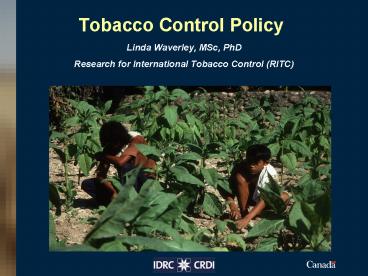Tobacco Control Policy PowerPoint PPT Presentation
1 / 17
Title: Tobacco Control Policy
1
Tobacco Control Policy
- Linda Waverley, MSc, PhD
- Research for International Tobacco Control (RITC)
Insert your image here
2
Global Burden of Non Communicable Diseases (NCDs)
- Tobacco use linked causally to cancers,
cardiovascular disease, respiratory diseases,
tuberculosis, and diabetes - Population aging and changes in risk factors have
accelerated the epidemic of NCDs in many
developing countries - Burden of NCDs is increasing, accounting for
nearly half of the global burden of disease (all
ages) - Many developing countries now face a double
burden
3
Why is Tobacco Unique as a Policy Issue?
- Tobacco use sustained through addictive
properties, low prices, social norms, vigorous
marketing by powerful multinational corporations - Perceived by many to contribute to social and
psychological well-being - Tobacco epidemic exacerbated by complex factors
with cross border effects, including trade
liberalization, foreign direct investment, global
marketing transnational advertising, promotion
and sponsorship international movement of
contraband and counterfeit cigarettes.
4
Global Tobacco Consumption
- Approximately 1.3 billion people smoke cigarettes
(1 in 5 of the worlds population 1 in 3 of
those over 15) - Global prevalence (2000) 29 (47
men 10 women) - One in two long-term smokers will die from a
tobacco related disease - many before 65 - Tobacco expected to be the leading global cause
of death before age 65 by 2020
5
Past and Future Annual Deaths due to Tobacco Use
Source Who (2002) The Tobacco Atlas, p.36.
6
Stages of the Tobacco Epidemic
Source WHO, 1995, after Peto Lopez
7
Policy Challenges in Developing Countries
- Appropriate balance between
- Population Strategies
- High Risk Strategies
- Need to switch from an infectious disease
paradigm to primary and secondary prevention - Need to incorporate economic policies as well as
health policies (e.g. tobacco taxes)
8
The Framework Convention on Tobacco Control (FCTC)
- First global treaty to focus on a health issue
- Negotiated under the auspices of the WHO
- Came into force in Feb. 2005 following
ratification by 40 countries - 168 signatories 116 parties
- Includes demand and supply reduction strategies
9
The FCTCincludes a variety of policy measures
- Price and tax measures to reduce demand
- Non-price measures
- Protection from exposure to tobacco smoke
- Regulation of the contents of tobacco products
- Regulation of tobacco product disclosures
- Packaging and labelling of tobacco products
- Education, communication, training and public
awareness - Tobacco advertising promotion and sponsorship
- Demand reductions measures concerning tobacco
dependence and cessation
10
The FCTCincludes a variety of policy measures
- Supply reduction provisions include
- Illicit trade in tobacco products
- Sales to and by minors and
- Provision of support for economically viable
alternative activities.
11
Recurring Concerns regardingTobacco Control
Research
- Lack of standardized and comparable data
- Need to focus on high-risk populations
- Absence of a network for communication of
information, data, and best practices - Need for better understanding of knowledge
brokering - Lack of adequate capacity for tobacco control
research (especially in non-health related areas
such as economics and policy analysis) - Need for concerted mobilization of human and
financial resources
12
South Africaas a model for policy-making
- A policy window
- A champion in the Minister of Health
- Strong advocacy
- A sound research base
- Framing as both a health and an economic issue
13
Cigarette prices and consumption
14
Cigarette excise taxes and government revenue
15
Tobacco Control as a Model for Other Risk Factors
- Comprehensive approach no silver bullet
- Prevention, promotion, protection and treatment
- Successful strategy includes programming, policy,
research, communication and community development - Multi-site interventions
- Evidence-based policy
- Country-specific evidence
16
Thank YouResearch for International Tobacco
Control (RITC)http//www.idrc.ca/ritc
17
Prevalence () of Never, Former and Current
Smokers in Controls by Region (INTERHEART Study)

